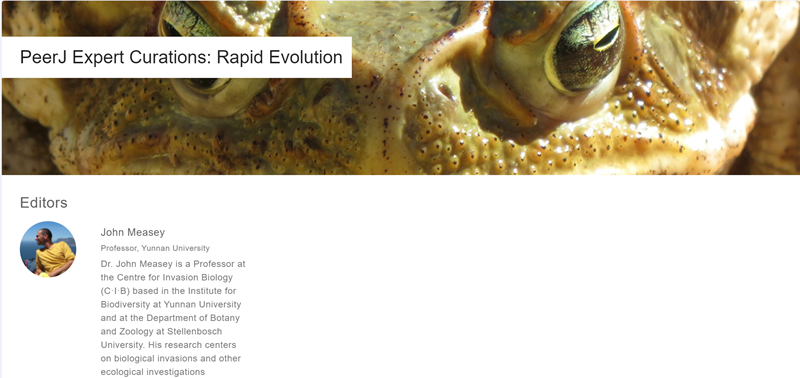PeerJ Expert Curations: Rapid Evolution
I was asked to curate a set of PeerJ articles around a topic, and chose to do this on Rapid Evolution. You can read the summary that I wrote and the articles I picked on this blog at PeerJ.
Curation Summary
Darwin’s (1859) theory of evolution involved ‘slow steps’ that precluded the concept of ‘sudden leaps’, instead advancing by ‘taking advantage of slight successive variations’. Although Darwin’s ideas still form the basis of our modern understanding of evolutionary processes, we now have examples of how the process can occur in the sudden leaps that Darwin himself eschewed. Documenting and investigating how these rapid evolutionary processes occur has become an important theme in 21st century life sciences. In this small selection of papers published in PeerJ Life and Environment, I highlight how scientists have gained insight on rapid evolutionary processes from multiple evidential sources, and how this has led to a better understanding of evolution today.
Rapid evolution as evidenced in PeerJ Life & Environment
Perhaps the best examples of rapid evolutionary processes are provided by the smallest living organisms. For example, Gutiérrez-Escobar et al. (2018) document how changes in genetic sequences of Helicobacter pylori sampled from patients in Columbia result in physical changes in the protein AlpA. Genetic mutations resulting in differences to transcribed proteins represent the most widely understood of evolutionary mechanisms. In their study, Gutiérrez-Escobar et al. show how the evolutionary mechanisms of gene conversion and purifying selection have diverged for this important gastric carcinogenic bacterium across a small spatial scale of Columbian cities during its short post-colonial history.
Dufour et al. (2018) use an invasion of Anolis lizards to study the evolutionary consequences on communication and behavior between native populations (A. oculatus) with and without an invasive congener (A. cristatellus). They found that in the 15 years since the introduction of A. cristatellus, populations in sympatry had decreased the proportion of display-time spent displaying (dewlapping), stressing how behavioral traits might be the first visible signs of rapid evolutionary processes taking place.
Invasive species are vulnerable to native species that may prey upon them. The ways in which these communities evolve can be surprising, especially when similar species are already present in the recipient environment. Schilthuizen et al. (2016) document how the native insect community on invasive cherries (Prunus serotina) is more diverse (but less dense) than those on native (Sorbus aucuparia) in a park in the Netherlands. Moreover, a beetle (Gonioctena quinquepunctata) collected from native and invasive trees displays different preferences in a choice test.
Regular collections of black rats (Rattus rattus) from Anacapa Island (USA) over a period of 60 years allowed Pergams et al. (2015) to make a series of detailed morphological measurements to track changes in cranial measurements. In this short period, the rats’ skulls had increased in size by between 3 and 10%, probably as a result of their island diet. Meanwhile, endemic deer mice (Peromyscus maniculatus) on the island became smaller after the introduction of the rats, likely through competition and predation.
The immune system must have the ability to respond rapidly to potential pathogens but this response is energetically expensive, and is predicted to be downregulated in invasive populations. Previous studies had shown immune response differences between populations of Rhinella marina from the core and at the invasion front in Australia. Selechnik et al. (2017) tried to replicate these results, using an experimental approach, but failed to find a difference between these two invasive populations. This reminds us that despite the overwhelming evidence for rapid evolutionary processes, we still need to proceed with caution when accepting results of previously published studies. More importantly, we need to be able to publish negative results in order for science to advance.
These exemplars also serve to demonstrate the utility of invasions to study rapid evolutionary processes in situ. While the impacts of these invasions are widely acknowledged to be largely detrimental to the recipient environment, they can serve as analogies to the impending changes to global climate due to anthropogenically mediated climate change. Why do some species thrive while others decline? Moreover, they offer scientists an opportunity to gain insight on the most fascinating and fundamental of all topics in life sciences and the environment: evolution.

